Brush strokes (bihua 筆畫) are units of which Chinese characters are composed. They correspond to the movement of the brush during the writing process. The shape of brush strokes has been standardized for the normal script (kaishu 楷書) and is imitated in book printing, especially the Song-period style Songti 宋體 and its modern variant, the Fangsongti 仿宋體. The number of brush strokes in a character is used for indexing, for instance, in dictionaries.
Brush strokes only appeared with the invention of the chancery script (lishu 隸書) with its square or angled appearance. The older seal script (zhuanshu 篆書) has a more soft appearance with round edges which is not easy to write with a brush. This change of the appearance of characters and the writing method resulted in a more abstract form of characters, in which the original shapes are often not any more recognizable. Chinese characters so became ever more ideographic than pictographic.
Many dictionaries do index characters in a two-layer system, first according to the radical (radicals themselves also arranged according to the number of brush strokes), and then according to the number of residual strokes. Instead of using the radical, quite a few dictionaries and lexica make exclusively use of the number and shapes of brush strokes to index characters.
There are several different types of brushstrokes, depending on length, shape and brush movement. Traditional calligraphers developed several models with different complexities. The most important types of brush stokes are:
| Basic strokes | Extended strokes | ||||
|---|---|---|---|---|---|
 |
點 dian | dot | |||
 |
横 heng | horizontal line |  |
横撇 hengpie | horizontal stroke with a downward hook |
 |
横折彎鉤 hengzhe wangou | horizontal stroke with a long bent hook | |||
 |
横折折撇 hengzhe zhepie | horizontal stroke with a double broken slant | |||
 |
横折折彎鉤 hengzhe zhe wangou | horizontal stroke with a double broken hook | |||
 |
横折挑 hengzhe tiao | horizontal stroke with a slant hook | |||
 |
竪 shu | vertical line |  |
竪折 shuzhe | vertical stroke with a horizontal hook upwards |
 |
竪折撇 shuzhe pie | vertical stroke with a double broken slant | |||
 |
竪折折鉤 shuzhe zhegou | vertical stroke with a double broken hook | |||
 |
撇 pie | slant to the left |  |
撇折 piezhe | left slant with a sharp bend towards the right |
 |
撇點 piedian | left slant with a dot towards the lower right | |||
 |
捺 na | slant to the right | |||
 |
挑 tiao | dot strechted to the upper right | |||
 |
折 zhe | right edge downwards | |||
 |
鉤 gou | vertical hook to the left | |||
With the invention of the brush, the modern style of calligraphy developed with up to 16 different stroke patterns and several rules how to write a character and its elemens. Every character can be separated into a certain number of strokes, the simpliest character being a single horizontal stroke 一 "one", one of the most complex characters, written with 48 brush strokes, is 龘, consisting of three dragons 龍.
The six basic brush strokes are, according to the Ming-period 明 (1368-1644) encyclopaedia Sancai tuhui 三才圖會:
| 一 | horizontal (heng 橫) |
 |
|
| 丨 | vertical (shu 竪 or zhi 直) |
 |
|
| 丶 | dot (dian 點) |
 |
 |
| 丿 | slant to the left without hook or slant to the right with hook, with many derivatives (pie 撇) |
 |
 |
| 亅 | hook (gou 勾) |
 |
 |
| 乁 | slant to the right bottom (ne 抐 or na 捺) |
 |
This basic set can be enlarged to eight different strokes, exemplarified in the character yong 永:
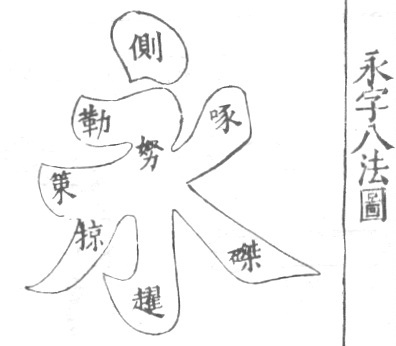 |
| dian 點 "dot" or ce 側 |
| heng 橫 "horizontal" or le 勒 |
| shu 竪 "vertical" or nu 努 |
| tiao 挑 "lift-up" or ti 趯 |
| zuoshang 左上 "towards upper left" or ce 策 |
| zuoxia 左下 "towards lower left" or lüe 掠 |
| youshang 右上 "towards upper right" or zhuo 啄 |
| youxia 右下 "towards lower right" or zhe 磔 |
From Sancai tuhui 三才圖會, Renshi 人事, 3. |
Today, there are five different types of strokes, exemplarified in the character zha 札:
 |
一 heng 橫 "horizontal" |
| 丨 zhi 直 "vertical" |
| 丿 pie 撇 "bend to the lower left" |
| 丶 dian 點 "dot" |
| 乙 na 捺 "bend to the lower right" or "hook" |
The sequence of brush strokes (bishun 筆順) is also subject to strict rules and important for indexing characters, at least concering the first few strokes. The basic rules of stroke order are:
| from left to right |
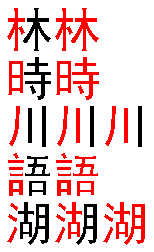 |
| from top to bottom |
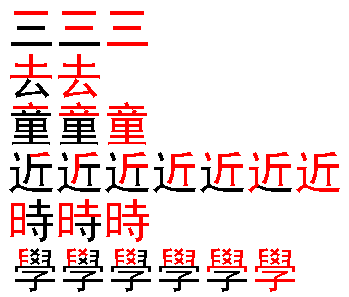 |
| vertical strokes in the middle are written first if the middle stroke is longer |
 |
| left and right enclosures are written last |
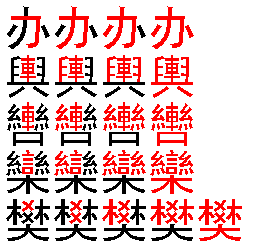 |
| from outside to inside |
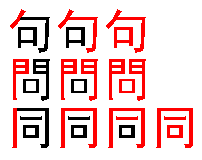 |
| first fill the box, then close it |
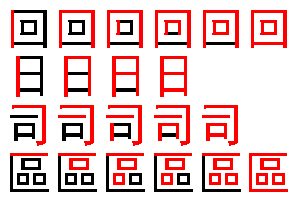 |
| lower enclosures are written last |
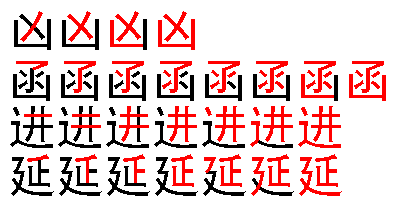 |
| first horizontal, then vertical |
 |
| vertical strokes in the middle are written last if passing other strokes |
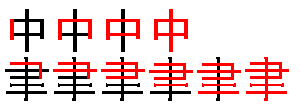 |
| hooks beginning vertically are written last if touching or passing other strokes |
 |
| first from right to left (pie 撇), then from left to right (na 捺) |
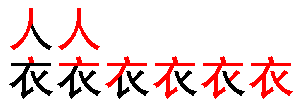 |
| in x-crossed parts first the left slant, then the right |
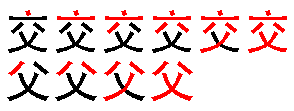 |
| protruding horizontal crossing strokes are written last |
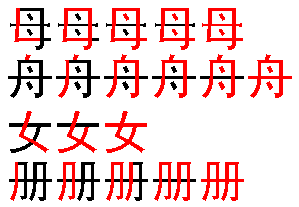 |
| dots in the upper left corner are written first |
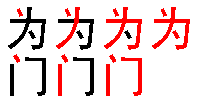 |
| dots in the upper right corner or inside are written last |
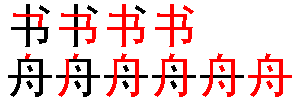 |
Yet in calligraphy, these rules are often not adhered to.
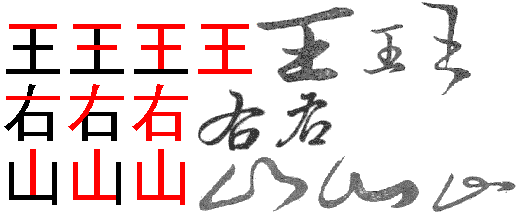 |
In the first character 王, the calligrapher wrote the vertical stroke before combining the two lower horizontal strokes. In the second, 右, the slant vertical character was written before the horizontal one, and in the lower examples, the calligraphers begin with the left part of the character, in opposition to the rule, which demands that the central part (the vertical stroke) is written before the enclosure. |